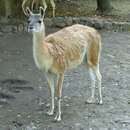en
names in breadcrumbs


The llama (Lama glama) is a large animal (around 130 to 155 kg) and is able to carry a load of 96 kg at a rate of 26 km/day over rugged mountain terrain at an elevation of 5000 m. Llamas played a major role in the development of the Inca Empire, providing invaluable service as beasts of burden (the llama is apparently the only animal domesticated by native peoples of the New World that was used for this purpose). Llamas were also used as a source of meat, fat for making candles, materials for making clothes and rope, and dried excrement that could be used as fuel. Llama hemoglobin has a an unusually high affinity for oxygen and the blood contains an usually high concentration of red blood cells, at least partially explaining the ability of llamas to function so well at high altitudes. (Nowak 1991 and references therein)
The llama is one of four South American camelids (mammals in the camel family) recognized today, two of which are wild species, the guanaco (Lama guanicoe) and the vicuña (Vicugna vicugna), and two of which are domesticated forms, the alpaca (Lama pacos or Vicugna pacos) and the llama.
Wild vicuña and guanaco diverged from a shared ancestor two to three million years ago. (Wheeler 1995). At one time it was widely believed that both the alpaca and llama were derived from guanacos. However, in light of new archaeozoological evidence from 6000 to 7000 years ago in the central Peruvian Andes linking alpaca origins to the vicuña, Kadwell et al. (2001) investigated the origins of these domesticated forms using mitochondrial and nuclear DNA markers. Their results confirmed the hypothesis that the llama is derived from the guanaco, but indicated that the alpaca is actually derived from the vicuña, not the guanaco (their investigation also revealed genetic evidence of historical hybridization and gene flow, at least among domesticated forms). Chromosomal analyses have also indicated that the llama was derived from the guanaco and the alpaca from the vicuña (Marín et al. 2007).
Like the guanaco, the llama feeds by both grazing and browsing (the vicuña and alpaca are strictly grazers) (Nowak 1991 and references therein).